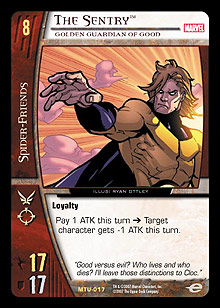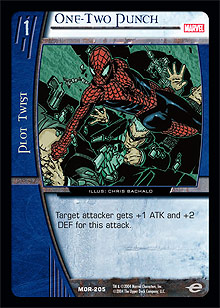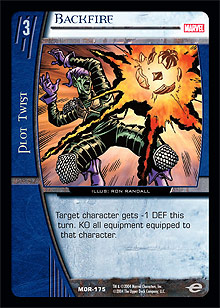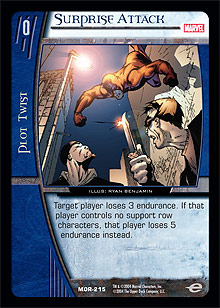
|
The Sentry™
Card# MTU-017


While his stats aren’t much bigger than those of the average 7-drop, Sentry’s “Pay ATK” power can drastically hinder an opponent’s attacking options in the late game.
Click here for more
|
|
|

|
|
|

 |
 |
|
|
| |
|
Today I’m going to go through the common non-character cards in a very rough draft order from strongest to weakest. This ranking will vary from draft to draft and is by no means a definitive correct order for every player or for every strategy. It is simply what I’ve found to work best for me. I’ve included some logic behind the rankings and overlooked tips on using these cards and drafting around them. Even if this list were "accurate," drafting isn’t just about taking the "best" card—it is about drafting a complete, well-rounded, synergistic deck. With that in mind, here is a framework from which to base your own decisions.
 Acrobatic Dodge Acrobatic Dodge
The best common card around to make sure your opponent doesn’t wreck your board when you don’t have the initiative. If you have a character defending who would trade with an attacker, don’t be too eager to play Acrobatic Dodge, as it can be trumped by Flying Kick. If, on the other hand, the first trade would allow your opponent to make a follow up attack on a protected character, especially one with range, in which you’d lose that character at no loss to your opponent, then you are best off making a stand right there. Acrobatic Dodge is superior to almost any other card on the list since it can be so important to shut your opponent down when he or she has the initiative. It isn’t all that infrequent that this card makes the turn seem like you had the initiative.
Flying Kick
The best card in this group for pushing through damage and making sure you can take down the biggest character in play. You get so much flexibility with this card. You can send somebody to the air and take down a potential reinforcer, then go roaring into the front row character that would have been receiving reinforcement. As I mentioned, it can at times be a counter to Acrobatic Dodge and at others be much more devastating. This card is comparable in power to Acrobatic Dodge. Flying Kick may be better in a deck that wants to makes sure the game doesn’t go to the later turns, for example if you don’t have any 7-cost characters.
Nasty Surprise
The name kind of says it all. At minimum, this usually guarantees your opponent takes a decent amount of endurance loss. At best, it ensures that you aren’t the only player with multiple stunned characters when you don’t have the initiative.
Finishing Move
This is a tricky card to play correctly and not necessarily amazing in decks without many small characters. If you’ve read my previous articles I’ve discouraged players from building decks with too many small (1–2 cost) characters. If you manage to pick up a couple of Finishing Moves, make sure you do pack your deck with at least of handful of such small characters. Otherwise, there aren’t that many opportunities to exhaust a character to Finishing Move when you wouldn’t be better off just attacking with that character instead. Sure, it is exciting if you take down your opponent’s largest character then Finishing Move it, but you could have been selecting another card to help guarantee you take down that character in the first place and to push through damage with your other characters instead. This is certainly a card to play around in draft. If it doesn’t put you at risk, take down smaller guys first in an attack sequence so they can’t be exhausted to KO your bigger character who might be getting stunned in another attack.
 One-Two Punch One-Two Punch
This is no Flying Kick, but it is a solid combat trick. It is good answer to power-ups and several of the defensive plot twists. The card isn’t terribly exciting, but proves its worth more often than not.
Dual Sidearms
This is generally the best 0-cost equipment for a deck. You can reliably push through extra endurance loss beginning with the turn it sees play, and you have a character than looks very impressive compared to its peers for a number of turns. It is a gift that just keeps on giving. As with the other equipment, it doesn’t get up there with the top plot twists, since unlike those, you aren’t getting the dual utility of being a resource and a surprise.
Cover Fire
I haven’t really had that much luck with this card, but if I’m going to put Acrobatic Dodge up at the top because it is a great defensive plot twist, I can hardly bury this one down in the dumps. When it works, it should prove just as good if not better than Acrobatic Dodge. It is that whole “when it works” that is the problem. All too often, your opponent has a character come over and attack your only character with range first, or if he or she doesn’t, the +2 DEF isn’t enough. Maybe I’m just not drafting enough characters with range or setting my formation up in a way to trap my opponent into making an attack on my non-ranged character first. At any rate, I’m not ready to give up on this card yet.
Burn Rubber
This is right up there with Nasty Surprise for punishing an opponent who is attacking your smaller guys. It’s especially good on the final turns of the game when players are deciding to go after endurance totals rather than board position. The trick is guessing what amount of endurance loss constitutes a good use of this card. Generally, if you're saving 5 or more endurance, you're getting a good deal.
Base of Operations
Not the easiest card to evaluate. The value of the card selection you get off this card can’t be denied. You want to get to your cards and get past the chaff. If you get this out right from the start, you can be saying “yes” or “no” to at least a handful of cards, and you are likely to decide that at least a few of the cards you see are better off being replaced by the next random card on the top of your deck. If you figure your success is going to be defined by getting to a couple of bombs in your deck, this is you best friend.
Unstable Molecules
This card can be a real headache for an opponent. While you can’t keep pushing through damage turn after turn with this like you might with Dual Sidearms, you can make a stand with this on a character at a crucial turn, either forcing a standoff or forcing your opponent to blow a strong plot twist to get through. I lean toward the offensive rather than the defensive equipment (unlike the Acrobatic Dodge/Flying Kick comparison). When your opponent sees a defensive card, he or she can usually take the appropriate measures to still have a good turn, by taking care of business with a good team attack, for example.
 Backfire Backfire
This card again shines in its versatility. Don’t be deluded into thinking this is a card just for taking down equipment. The -1 DEF to any character whether it is attacking or defending is sure to prove useful at some point in the game. If you can take down any equipment in the deal, that is just gravy.
Micro-Size
I’m ranking this assuming you aren’t going to be seeing Dr. Doom at all. If you think he’ll be seeing play with any frequency the stock of this card goes up a lot, since you are getting a card better than One-Two Punch rather than one that is worse. Then again, you aren’t going to get Dr. Doom out every game you draw this card. Still, there is a lot to be said for the -1 ATK/-1 DEF to a defender when two equivalently costed characters are in battle.
Advanced Hardware
It is hard to know exactly where to rank this card among the others. When you attack with the equipped character, you get a very nice +3 ATK boost, and when you're defending, it isn’t trivial to take off 3 of your opponent’s endurance as your character is going down for the turn. And that +3 ATK usually limits your opponent’s options by warding off some of his or her otherwise larger characters. The problem is finding the right time to play the card. I guess you can’t hope to spend to the max with your characters every turn, at this is going to generally be more exciting than playing an additional 1 cost character on most turns of the game. All in all, it is a solid card and leaves you with good options when you don’t have an ideal character to play.
Borrowed Blade
The difference between this and Dual Sidearms probably isn’t that big. By saving it for an opportune situation, you can come up way ahead in an attack and then have it still sitting around for future turns.
Medical Attention
It’s possible I’m way off on my evaluation here. Unfortunately, I find that when it rains it pours. That is, when at least two of your characters get stunned, you don’t have a ready body hanging out to take care of your wounded. More often than not, that theoretical character went down as well before the recovery phase, or you may have been served just as well by reinforcing with it. If you have a lot of small characters, this card is bound to be better than I’m giving it credit for.
Team Tactics
This card more or less acts as if you had made a team attack in which you do breakthrough endurance loss and you get to choose who the defender takes down. Not a bad deal at all. This card is excellent for handling situations when your opponent plays a character that is more than you can easily handle or for funneling endurance loss through a specific defender. The downside is that in a draft game, you might have characters of at least two team affiliations and as such you might not get too much out of this card when you really need to. The real question is how much more you are getting out of this card than just making a real team attack. The more characters you have of one team affiliation, the more exciting this card becomes.
Tech Upgrade
It’s hard to knock a card that allows you to exhaust a defender that will be going down or a small character on an early turn to fetch an equipment of your choice. Then again, you would be playing this card in a slot that might otherwise be a tricky combat plot twist or an extra character card to better ensure your character plays on each turn. If you have several equipment cards in your deck, this card may be worth it, though, especially if you have a number of small characters. Otherwise you might not find a great opportunity to play the card, or worse, you may draw it after you’ve already drawn all your equipment.
 Surprise Attack Surprise Attack
This doesn’t do anything at all to help you out on the board, and yet it is more than likely to take out ten percent of your opponent’s original endurance total. That may not sound like much, but many games come down to just a few endurance points. If you aren’t pulling many big characters, Surprise Attacks can fit nicely into a draft deck with many small characters where you are just trying to finish the game before your opponent even has the chance to play his or her bigger characters. If you are going this route, make sure to gets as many ATK boosters (Nasty Surprises, Dual Sidearms, Flying Kicks, and so on) as possible.
Doomstadt
Let’s just say this card is very good if you have more than one Dr. Doom and playable with even just one, knowing it makes him very durable. Besides the stat bonus, this card does enable and improve some other cards as well (Faces of Doom, Sub-Mariner, Micro-Size, and so on).
Reconstruction Program
If you have multiple characters of the same name, this card goes up a lot in value, since you can power-up your character then fetch it back with this for another power-up. Certainly if you are drafting Sentinels, this can be nice to repopulate your horde. Also, there are times when your two largest characters get stunned and you haven’t drawn another big character. Then this card helps you get back a decent-sized character play for the current turn. I find these situations don’t come up enough to suit my tastes, though, and generally I’d rather have another card in my deck.
Last Stand
I’d argue that if you have three or more stunned characters and your opponent is still making another attack, you might want to be throwing in the towel. Then again, this card might make for a good story?
If you think I’ve shamed your favorite card by it’s placement on this list or that I’m severely overestimating a certain card, please send me your comments at DHumpherys@metagame.com.
|
| |
| Top of Page |
|
 |
|
|
 |